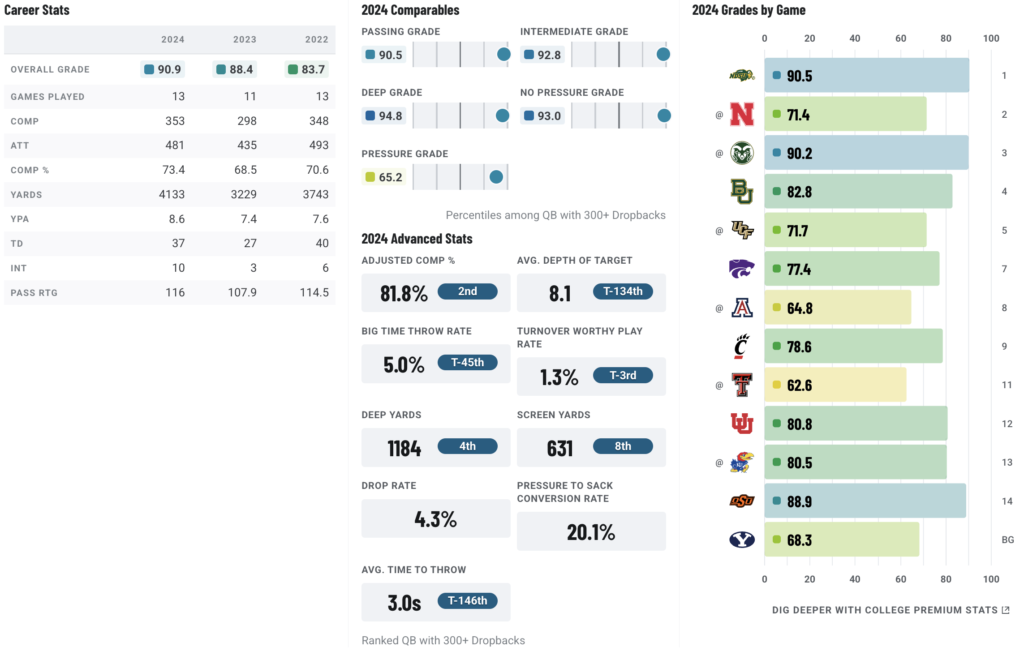
- Sanders stays efficient under pressure: Despite a below-average sack rate, the Colorado quarterback ranks in the 80th percentile in PFF passing grade on third-and-long situations from 2022 to 2024.
- Consistency is his calling card: Sanders’ projected efficiency metrics remain steady regardless of supporting cast or scheme, indicating he could be a reliable option at the next level.
- 2025 NFL Draft season is here: Try PFF’s best-in-class Mock Draft Simulator and learn about 2025’s top prospects while trading and drafting for your favorite NFL team.
Estimated Reading Time: 3 minutes

The 2025 NFL Draft is quickly approaching, and the draft class is rounding into shape. With the final PFF big board live and mock draft season in full swing, teams and analysts are gaining a clearer picture of the top prospects and the deepest position groups in this year’s class.
Projecting college football stars to the NFL is never an exact science, but by utilizing PFF grades and advanced data, we can gain a clearer picture of how prospects might transition to the next level. By analyzing performance trends, key metrics, and positional benchmarks, we can identify which players are best positioned to succeed — and which may face challenges — when transitioning from college to the pros.
Let’s take a look at Shedeur Sanders, who earned an elite 90.9 PFF grade in 2024 with an adjusted completion percentage of 81.8%.

SCOUTING SUMMARY
If you didn’t know his last name, you’d still recognize that Shedeur has NFL bloodlines—or at least that he’s been around high-level football minds—just from watching his tape. He followed his father from Jackson State to Colorado and has developed into a legitimate NFL prospect.
His scouting report starts with his clean fundamentals. At under the 30th percentile in both height (6-foot-1.5) and weight (215 pounds), those fundamentals are paramount, allowing him to maximize his average arm talent. His throwing motion is highly repeatable, leading to good accuracy and ball placement. His experience at the position helps him see the field well, both pre- and post-snap, resulting in very few turnovers and turnover-worthy plays throughout his career.
His mobility is limited, especially by NFL standards, and he has a bad tendency to hold onto the ball too long, leading to a high number of sacks. Despite his smaller stature, he grades well in third-and-long situations and when throwing over the middle. His top trait is likely his mentality—he’s tough as nails in the pocket and has delivered some true “ice in his veins” throws under pressure and on big downs.
WINS ABOVE AVERAGE
WAA represents the number of wins a player is worth over an average college football player and is a metric that evaluators can utilize to assess performance. It combines how well a player performed in each facet of play (using PFF grades) and how valuable each facet is to winning football games. The result is a first-of-its-kind metric that enables cross-positional valuation and predicts future value at both the player and team levels.
HOW SHEDEUR SANDERS RANKS IN THE STABLE METRICS (2022-24)
Stable metrics are more reliable indicators of future success than volatile, high-variance stats. The most stable facets of a player’s performance are those measured over larger sample sizes, even if they may seem less impressive or “easier” on the surface. These metrics provide consistency, making them more predictive over time. While unstable metrics may capture highlight plays, they often fluctuate from year to year. Prioritizing stability provides a clearer picture of a player’s true ability and long-term potential.

Shedeur Sanders’ stable metrics are impressive across the board, with one glaring exception: his 15th-percentile sack rate. The former Colorado Buffalo consistently held onto the ball too long in 2024, averaging 3.18 seconds to throw — the ninth-highest mark among FBS quarterbacks with at least 200 dropbacks. If that trend continues in the NFL, his offense could find itself behind the chains far too often to sustain drives.
SHEDEUR SANDERS’ PROJECTIONS
In league-average circumstances, here are Sanders’ projections for yards per attempt and completion percentage as an NFL rookie:
Sanders’ rookie-year projections in a league-average scheme with a play-action rate of 25%, a pressure rate of 35%, a quick-throw rate (under 2.5 seconds) of 50% and a short-throw rate (before the sticks) of 63%.
Let’s examine how Sanders performs with improved surroundings. Even when given a low pressure rate, a high play-action rate and more downfield opportunities, his projected yards per attempt and passing grade per snap remain unchanged. This suggests that our projections do not foresee a higher ceiling for Sanders, even in more favorable conditions.
Sanders’ 2024 projections in a situation where 25% of his dropbacks have pressure and he runs play action on 30% of his dropbacks.
Now let’s look at how Sanders fares in less favorable conditions. When facing a high pressure rate and a low play-action rate, his projected yards per attempt dip slightly, but overall, the change is minimal compared to the initial projections. This suggests Sanders profiles as a fairly consistent performer, regardless of his supporting cast or offensive environment in the NFL.
Sanders’ 2024 projections in a situation where 40% of his dropbacks have pressure and he runs play action on just 15% of his dropbacks.
BOTTOM LINE FROM PFF’s 2025 NFL DRAFT GUIDE
Sanders may be below average in stature and arm talent compared to NFL quarterbacks, but he plays the game cleanly, takes care of the football and is tough as nails with ice in his veins under pressure.
This news was originally published on this post .









Be the first to leave a comment